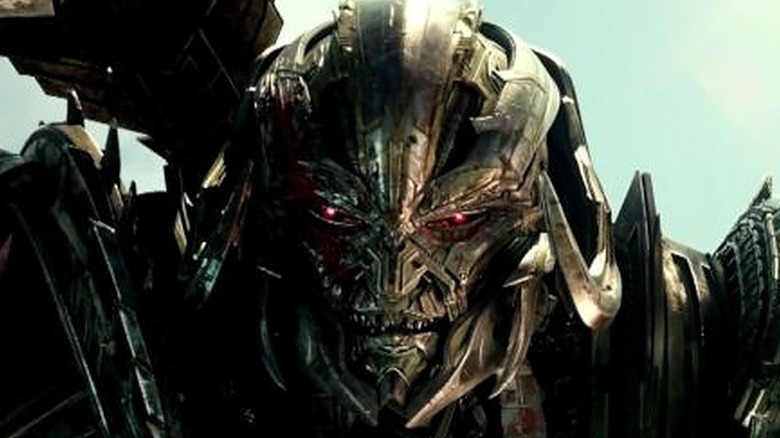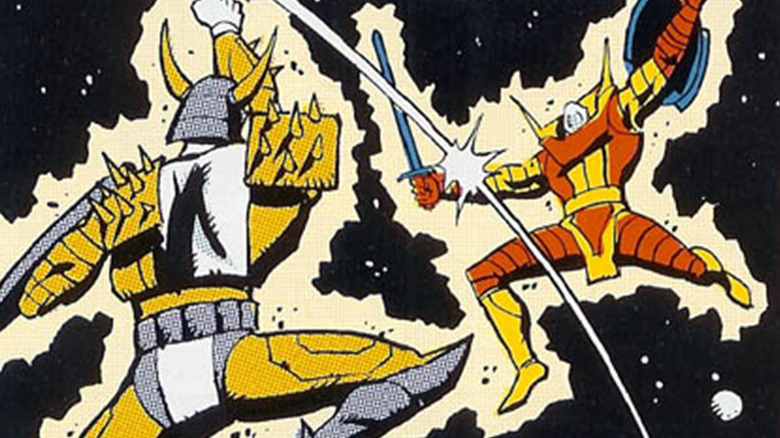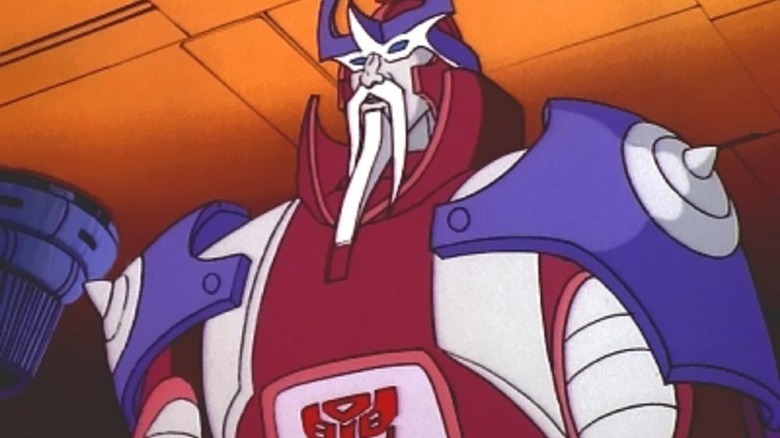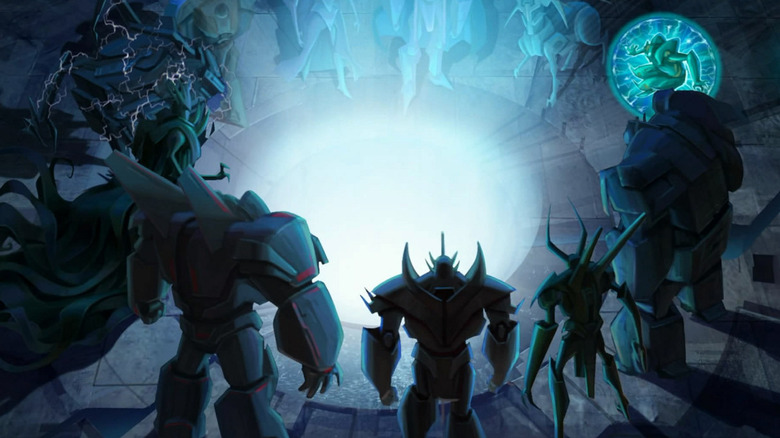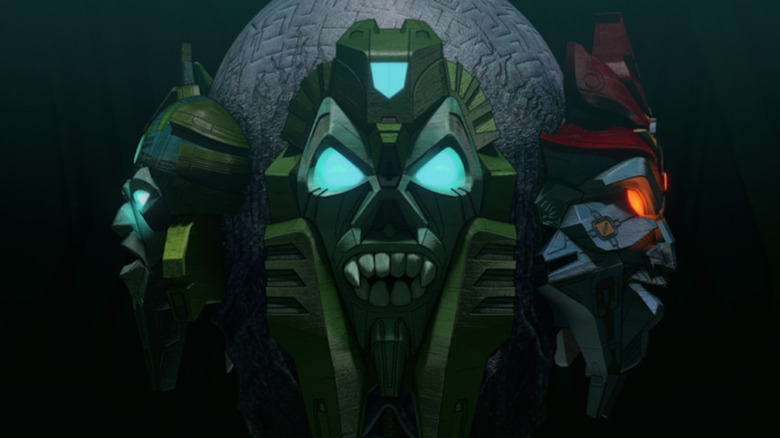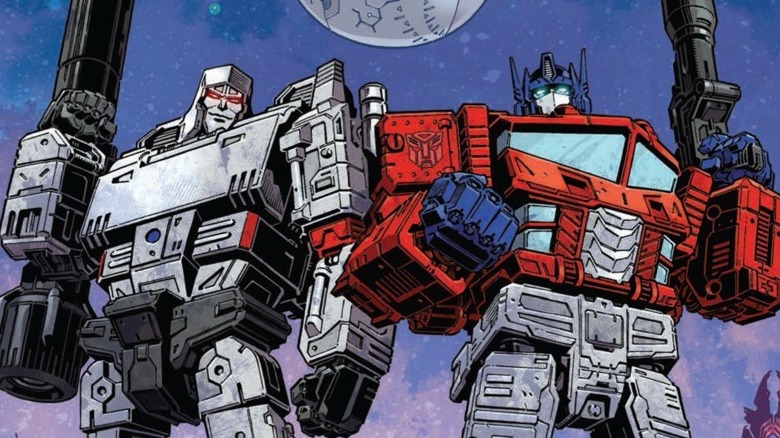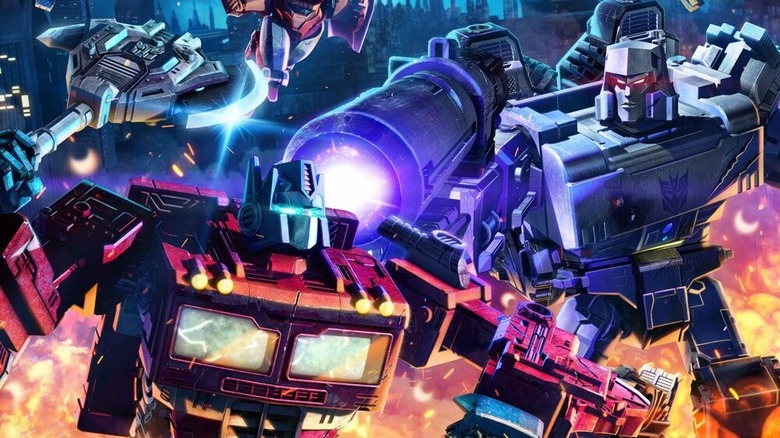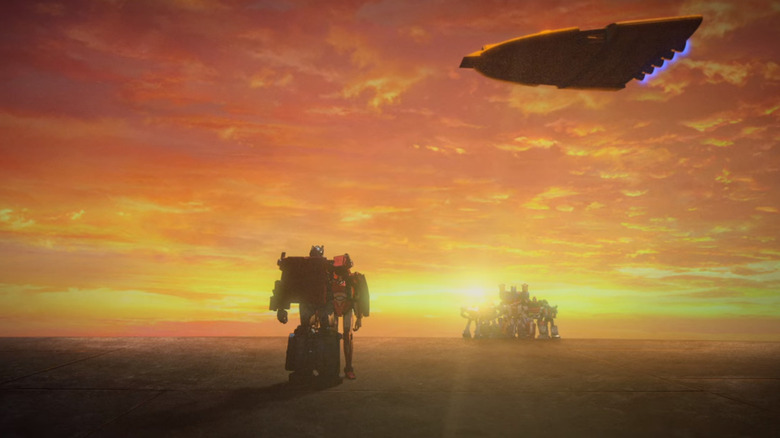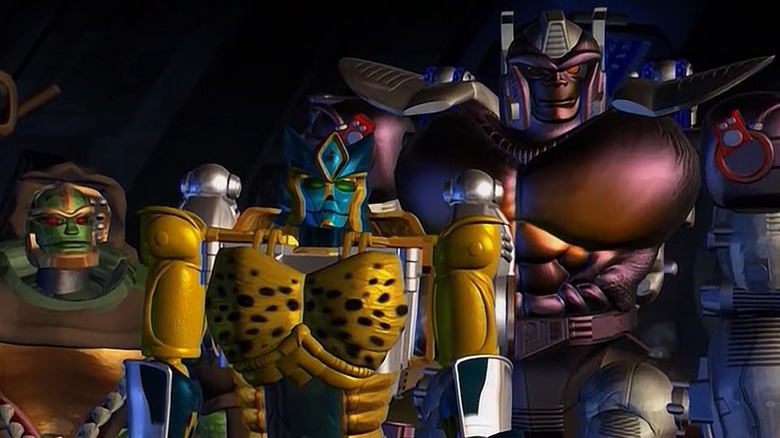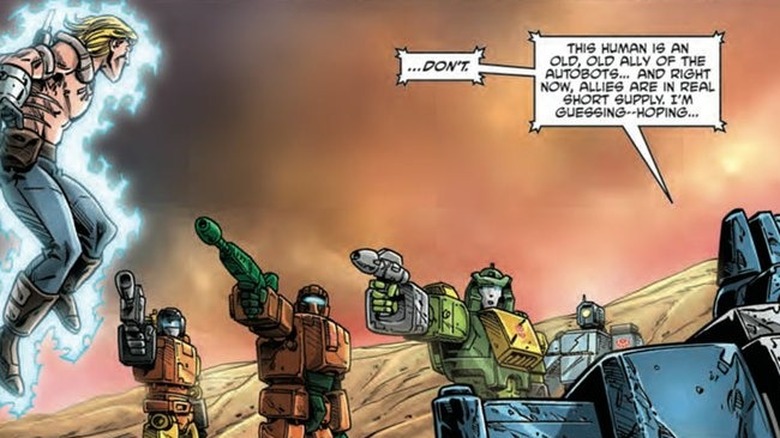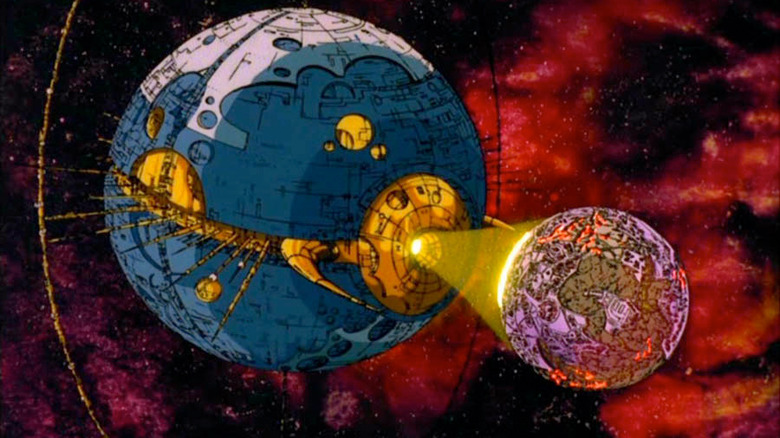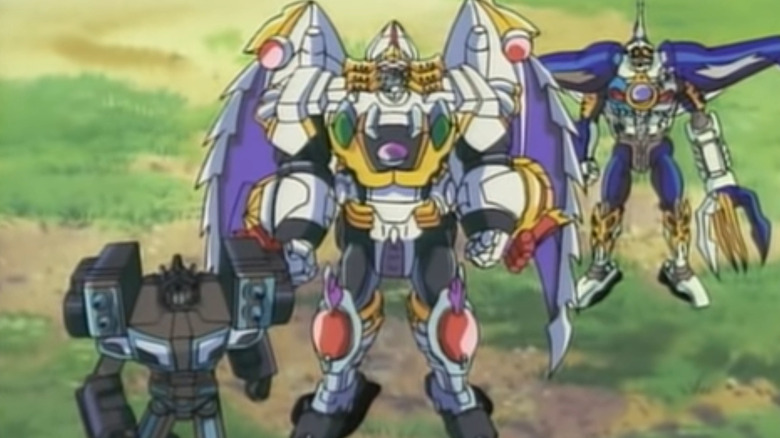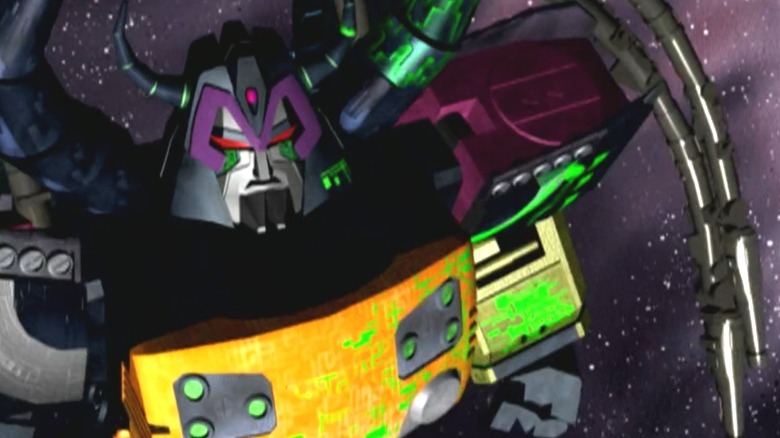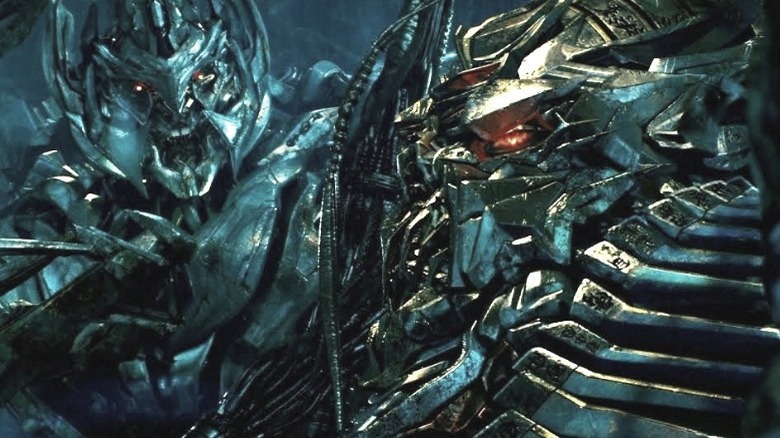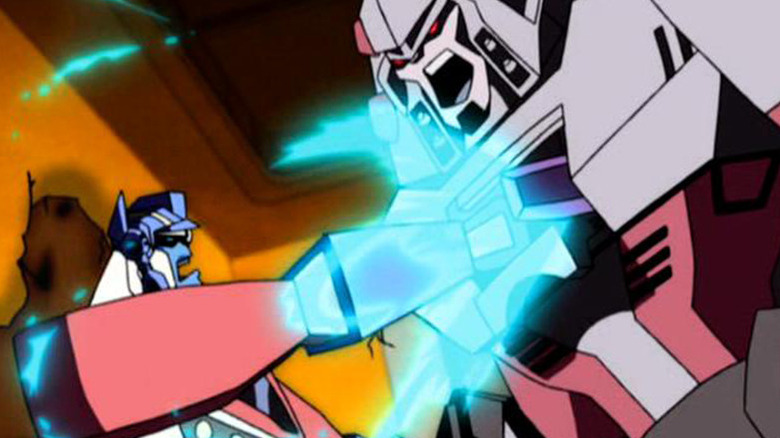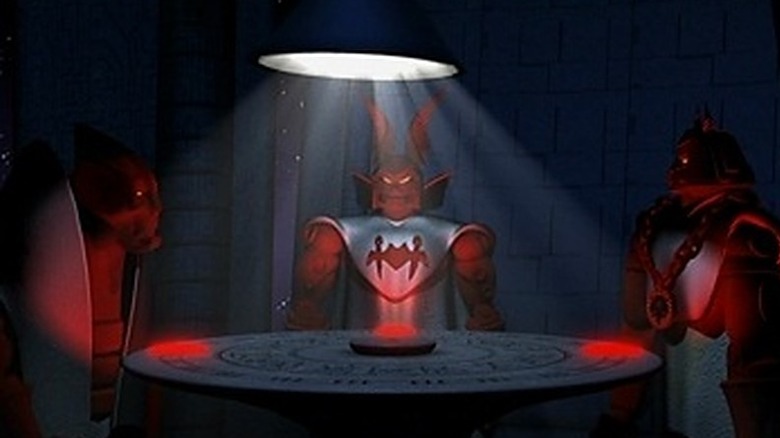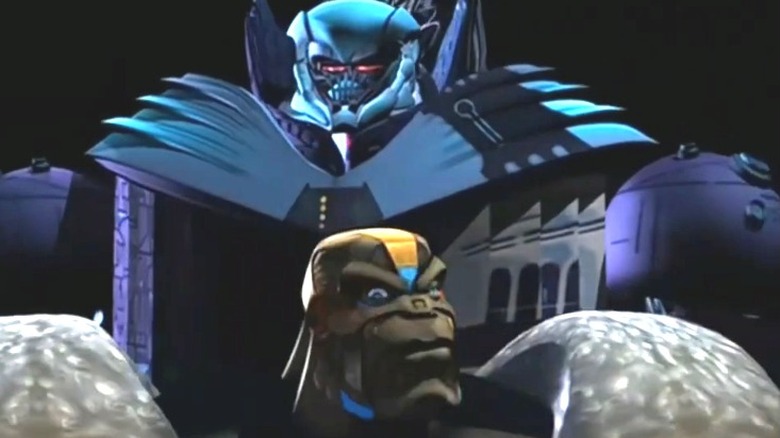The Entire Transformers Timeline Explained
When "The Transformers" cartoon first aired back in 1984 to — let's be honest — sell toys, few back then could have foreseen that nearly four decades later, the Transformers would be bigger, bolder, and more popular than ever. Though it remained pretty linear in its first 15 years or so, once the "Beast Wars" saga ended, virtually every new comic series, cartoon series, movie series, or game series rebooted the Transformers' story in a major way. The once-simple tales of Autobots and Decepticons battling on Earth have expanded into a multiverse that stretches back to the beginning of time and forward beyond the end of Optimus Prime and Megatron. These days, in other words, the franchise is more massive and all-consuming than Unicron himself.
Finding one definitive "Transformers" timeline is impossible, as Hasbro has never declared a — for lack of a better term — "Prime" reality. But weave in and out of the different universes that make up the Transformers' incredibly complex multiversal tapestry, and you'll soon realize that most sagas are variations of the Generation 1 narratives: the original stories first told in the Transformers' eponymous 1984 cartoon and Marvel comic book series. Patterns emerge, commonalities appear, and from the many we can pull one. Covering it all would take a book (or three), but we put together a unified timeline — with a few deviations to explore the really unique diverging realities — to help you navigate the increasingly complex "Transformers" multiverse.
Gods of good and evil do ancient battle
In the beginning, there was light and dark, order and chaos, good and evil. There was Primus and Unicron. First introduced with zero background in 1986's "Transformers: The Movie," Unicron, the cartoon eventually elaborated, was built by a mad genius. That explanation was a bit ... bleh. Certainly not the cosmic origin Unicron deserved. That came about in the comic books, where "Transformers" scribe Simon Furman explained that Unicron is a dark god locked in an eternal battle with the light god, Primus. The idea soon solidified into an integral part of Transformer lore, though like any myth, the details constantly shift.
Their story first appeared back in 1989 in Marvel's "Transformers" #61, then changed pretty much every time a different character told it. First Primus and Unicron are from a lost pantheon of gods, then by issue #74, Unicron is the destroyer of the previous universe, while Primus had been born to protect the current universe. In 2004's hardcover "Transformers: The Ultimate Guide," we're told The One created Unicron, then split Primus off of him. By the 2013 hardcover history "The Covenant of Primus," the two gods become a singular being that –- in a move that would put any soap opera to shame — develop opposing personalities and split into two.
Primus and Unicron may wax and wane in importance through the different realities, but they're almost always there, setting the cogs in motion for billions of years' worth of stories.
The first mythical Transformers are born
Eventually, Primus and Unicron's battle ends — or at least is put on pause. Whether that involves the two forces fighting to a standstill or Unicron being banished for a time, Primus remains wary of his enemy's return. He forms what would become the planet Cybertron around him and creates robotic beings in his likeness to do battle against the chaos bringer. Some stories, like "The Covenant of Primus," which serves as a history for the "Transformers: Prime" cartoon, refer to The Thirteen -– the original, legendary Primes who set all of Transformer history in motion. Other tales like IDW's 2016 "Transformers: Lost Light" comic book series tell the story of godlike Transformers with Primus' essence split between them. In the movie universe, these first Transformers are called the Dynasty of Primes.
Regardless of the tales, though, the first Transformers eventually, inevitably arise: powerful, wise, and ancient, measuring their lives in the billions of years. Membership shifts depending on the reality, but counted among their number have been Alpha Trion, the Autobot mentor and possessor of glorious robot whiskers from the original cartoon; Prima, the first Transformer created by Primus in the original Marvel comics; and Liege Maximo, the very short-lived big bad of Marvel's "Generation 2" comics. (After being mentioned throughout, he only made a single appearance on the last page of the last issue.) And, of course, there's Megatronus, The Fallen, from whom Megatron takes his name in the "Transformers" movie universe.
Primus creates the Transformers we know today
The first Transformers were just a handful of titanic beings, and it was only after them that Primus goes on to create an entire race of living robots: the Cybertronians. In some tales it happens shortly after the first Primes, while in others it takes millions or even billions of years. Time itself is fairly irrelevant at this point, as this is all still in an age of prehistory. Transformers may live for millions of years, but few still surviving were among the first born on Cybertron. Most of today's Transformers weren't around for their origins any more than today's humans were around for ours.
Of course, some stories refer to the AllSpark as the source of all Transformers' life, a concept first introduced in 2007's "Transformers" movie. The idea of the AllSpark grew out of 1996's time-bending "Beast Wars" cartoon, where the concept of a Transformer's "spark" was first established. Like a human soul, the spark is what makes each Transformer a living being. When Transformers die, they lose their spark, which means they can't just be repaired and turned back on like machines.
It didn't take long, though, for the AllSpark to be folded into Primus' tale, adopted by 2010's "Transformers: Prime" cartoon as the vessel through which he created Transformer life. While it's not necessarily always the case, in most realities, according to the official "Ask Vector Prime" Facebook page – which was originally created by Hasbro as a feature on their website – Primus himself is the "divine spark" that ignited Transformer life, millions and millions of years ago.
The Quintessons conquer the young Transformer race
Early Cybertronian history is murky and chaotic in even the best-documented of realities. Warring city-states, battling factions, expansion into the cosmos –- it's a lot, and few corners of the "Transformers" franchise get into ancient history more than in passing. There is one aspect of this time, though, that rears its ugly head time and time again: The Quintessons. Though fans didn't know it at the time, the brief, bizarrely creepy scenes with the tentacled Quintessons in 1986's "The Transformers: The Movie" were but a herald to things to come. In "The Five Faces of Darkness" episodes, the cartoon established that the mechanical, squid-like race had created and enslaved the Transformers before being overthrown. Many other versions of the Quintessons aren't creators, though, but conquerors.
In the 2002 Dreamwave comics series, "Transformers: Generation One," the Quintessons had conquered ancient Cybertron before being driven off. This led to a Golden Age that was spoiled when Megatron discovered that the Quintessons still secretly controlled Cybertron's ruling council (he gives this reason for starting the Great War). In the world of the "Transformers: Prime" television series, the Quintessons had infiltrated ancient Cybertron, bringing technology and prosperity as they secretly prepared the Cybertronians for slavery. And in Netflix's 2020 "War for Cybertron Trilogy," we learn that before Megatron fought Optimus and Ultra Magnus, he fought side by side with them under Alpha Trion to overthrow their Quintesson masters. Quintessons don't always appear at the same time in Transformer history, but when they do make first contact, it's often early, hostile, and brutal.
Megatron rises to power
After the Quintessons are driven off, the Transformers, for better or worse, become masters of their own fate. And across all of time and space, there's always been one Transformer determined to decide his own fate at any cost: Megatron. Early Megatron was pretty simple, but over the years, he's moved from bloodthirsty villain to freedom fighter-turned-despot. His story almost always begins the same, with him rising to power millions of years ago in the gladiator pits of Cybertron during some sort of Golden –- if not necessarily benevolent –- Age in Cybertronian history. 1986's "Transformers: UK" annual first established this path with the story of the brutal gladiator Megatron initially joining Optimus in a war between tyrannical city-states.
In Dreamwave's "Generation One" series, he rebels against the Quintesson-controlled Council of Ancients after they try having him killed for delving into Cybertron's secret past. By the time of IDW's 2007 "Megatron Origin" comic book mini-series, he starts out as a pacifist who chafes under the corrupt Cybertronian Senate. He moves from miner to gladiator champion, gaining followers until he has enough to overthrow the corrupt senate with Orion Pax -– who would go on to become Optimus Prime. Young Megatron often counts Optimus as a friend, and the two initially share ideals of Cybertronian freedom and self-determination. But though Megatron's rise often begins with promise, it always heralds the beginning of the end of a functioning Cybertronian society.
Megatron begins the Great War
Details might shift across realities, but one constant always remains: the Great War. It begins in nearly every reality, across every Cybertron, somewhere between nine and four million years ago when Megatron and his Decepticons declare war on the Autobots. The thing is, rarely since the earliest days of the cartoon has Megatron begun the war simply out of a desire to conquer. Rather, he tends to start it because he feels that only he has the vision to lead Cybertronians to victory, prosperity, and (enforced) peace. According to the "Transformers: Prime" prequel novel, "Transformers: Exodus," he begins the fight out of a seething jealously that his friend Orion Pax was chosen to be Prime rather than him after they both fought to overthrow the planet's caste system.
In IDW's 2012 mini-series, "The Transformers: Autocracy," Megatron joins with Orion to overthrow the tyrannical Zeta Prime. But once the formerly peace-loving bot gets a taste of power, he is loath to give it up. In the most recent account, Megatron kills Alpha Trion before the "War for Cybertron Trilogy" begins because he doesn't feel his mentor is leading the Cybertronians down the right path. The act of murder splits Cybertron into the Autobots and the Decepticons.
Evil is a relative term, and Megatron is an especially complex villain: From his perspective, the Great War is nearly always begun as a rebellion against an unfair system. Sadly, it also always leads him down a path where he becomes more brutal and tyrannical than those he once fought against.
Optimus Prime and Megatron leave Cybertron
The Great War rages for millions of years, devastating Cybertron in cataclysmic ways. Back in the franchise's earliest days, the war so decimates the planet that Optimus has to lead a contingent of Autobots off in search of more energy. Megatron pursues them in the Nemesis, and the ensuing attack causes both ships to crash to Earth, where the bots lie dormant for millions of years until they awaken in the original cartoon. In Marvel's original "The Transformers" #1, the war is so cataclysmic that it knocks Cybertron out of orbit: The Autobots and Decepticons crash to Earth when Prime leads the Ark on a mission to clear a path for Cybertron through an asteroid field.
In some cases, there are planet-wide tragedies that lead to Prime and Megatron's departure. In two of the most modern continuities –- the "War for Cybertron Trilogy" and 2018's "Cyberverse" cartoon — the exodus begins when Optimus ejects the AllSpark into space to keep it out of Megatron's hands. Prime only realizes his mistake after the source of Cybertronian life is gone and the planet slowly begins dying. He has no choice but to venture to Earth after it, with Megatron and his Decepticons trailing behind while the war continues back on Cybertron — until the planet dies. In the world of the "Transformers: Prime" cartoon, meanwhile, Megatron renders Cybertron uninhabitable, leading to the "Great Exodus" in which all Transformers flee the planet. No matter the reason, Optimus and Megatron leave Cybertron, and the war and planet are never the same.
The Beast Era begins in Earth's past
While Optimus and Megatron lie dormant on Earth, life continues on. For most Cybertronians, this means fighting the Great War. On Earth, it means something else entirely. In 1996's "Beast Wars," Optimus Primal (no relation to Prime) leads a small band of Maximals -– the future descendants of Autobots — through warp space in pursuit of this story's Megatron (who named himself after the original) and a tiny crew of Predacons -– the descendants of Decepticons. They crash on a planet that, we eventually learn, is prehistoric Earth in the earliest days of homo sapiens: Beast Megatron has traveled back in time after finding a message from the original Megatron with instructions to kill the dormant Optimus Prime. More time travel shenanigans ensue, but ultimately the Maximals fend off the Predacons and return to their own time.
"Beast Wars" quickly became a beloved corner of the "Transformers" universe, but outside of IDW's 2006 comic continuation, it was a fairly self-contained corner. Then came Netflix's "War for Cybertron Trilogy." In "War for Cybertron: Kingdom," Optimus Prime and Megatron lead their factions to Earth in search of the AllSpark. They survive their crashes and meet the Maximals and Predacons, who have already been on Earth for ages, having traveled back in time again thanks to a message from the original Megatron. The time travel gets even more wibbly-wobbly in this universe, but it firmly establishes the Maximal and Predacon prehistoric Earth battle as an integral part of the "Transformers" timeline.
The Transformers drag modern humans into their war
Humans are fickle creatures who tend not to care about things that don't involve us. That's why most Transformer tales begin in the modern era when the Cybertronians bring their war to Earth, thereby making it our problem. The stories of this time are too numerous and varied to recount, but you'll be hard-pressed to find a comic, cartoon, or movie that doesn't offer a version of the Autobot-vs.-Decepticon battle on modern Earth.
In the original cartoon and Marvel comics that set the stage for most Generation 1 realities, the Autobots and Decepticons awaken on Earth in the '80s after lying dormant for millions of years. They then continue their war on our planet, dragging humans into their endless conflagration. Some more modern tellings, like IDW's 2005 "Transformers" comic book series, have Optimus, Megatron, and their troops intentionally infiltrating modern Earth, having never lain dormant at all.
Sometimes the humans even bond with Transformers, becoming Headmasters. (Yes, that's their actual title.) Other times, like in Marvel's original series and the IDW continuation, "Transformers: Regeneration One," the humans gain superpowers to aid (or hurt) the giant bots. Whether our planet hosts Energon, the Allspark, powerful artifacts, or just good, old-fashioned human interference, one thing is always agreed upon: Earth, and its modern era, is a critical turning point of the Great War.
Unicron rises once more
Unicron was, is, and will be once again. The massive Planet Eater first threatens the Transformers in the far-flung "future" of 2006 for "The Transformers: The Movie." After Unicron reformats Megatron into Galvatron and creates a new, more deadly breed of Decepticon, Rodimus Prime defeats the galactic devourer once and for all. More or less. After he was defeated, he headed over to Marvel comics, threatening their universe beginning in 1990. He made his first appearance in "Transformers" #66, "All Fall Down." The story is notable for setting up Unicron's godlike powers and ability to mess with time by pulling Galvatron out of the future. The comics then created alternate futures, multiple Galvatrons, a few Unicron threats and, before there was even a multiverse, established a series of parallel timelines.
Since then, across timelines and multiverses, Unicron's return has become all but inevitable. In 2018, after over a decade of avoiding the ultimate evil, IDW comics finally brought Unicron in with a vengeance in "Unicron" #0. The massive battle spread across the franchise's comics, unified the Transformers, and brought 13 years of a comic book story to an end. Back on TV, meanwhile, his and Galvatron's time-travel manipulation brought the Autobots, Decepticons, Maximals, and Predacons crashing together in spectacular fashion in the "War for Cybertron Trilogy." Unicron even makes a (sort-of) appearance in the live-action movies, where "Transformers: The Last Knight" reveals that the Earth ... is Unicron. It doesn't matter where in the multiverse you land: Unicron is coming.
Other worlds: Robots In Disguise throws out all the rules
In one reality, the Autobots and the Decepticons never come to Earth to do battle. Instead, 2001's "Transformers: Robots in Disguise" cartoon tells the story of Optimus Prime leading his Autobots to protect Earth when Megatron and his Predacons (not Decepticons) target it. The show never gets into these Transformers' history much, but there are some interesting quirks. The "Robots" Ultra Magnus, for instance, is Optimus' brother, never forgiving his sibling for getting the Matrix of leadership instead of him. The bat-slash-jet-slash-two-headed-dragon Megatron brings the Predacons to Earth in search of the immensely powerful Fortress Maximus.
And the Decepticons? Well, they exist. Kind of. The only Decepticons in the entire universe are created when Megatron gets his hands on a small handful Autobot "protoforms" (Autobot blank slates) and brainwashes them into new, evil creations.
In the real world, "Robots in Disguise" was an adaptation of the anime "Transformers" series, "Car Robots." Over in Japan, there was a slew of anime series, all continuing from and building on the American shows. The adaptation, on the other hand, was the first departure into what would come to be many, many official "Transformers" reboots. Before that, shows and comics would pick through Generation 1 and offer tweaks and expansions unique to each story, but all falling under the main continuity. "Robots in Disguise" cut the timeline loose and gave creators free reign to explode "Transformers" lore in every direction imaginable.
Other worlds: Unicron goes crazy in Armada
Launched in 2004, "Transformers: Armada" was the second full reboot after "Robots in Disguise." In the world of the "Armada" cartoon, there aren't just Autobots and Decepticons -– there's also a third faction: Mini-Cons. And the Unicron of this world is very active. He, as we learn in the "Armada" episode "Origins," had disguised himself as the Cybertronian moon sometime in the distant past and created the Mini-Cons to kick the Autobot and Decepticon war into high gear. The tiny bots have the ability to boost the power of their larger brethren and, after battling over them for a time, both Autobots and Decepticons realize they are too dangerous and send them off into space.
The Mini-Cons end up on Earth, where they are rediscovered millions of years later by the Cybertronians, bringing the Transformers into the modern era and, as usual, dragging humans into their fight. Unicron, naturally, is revealed to be the big bad before being defeated at the end of the series. The story then continues with two more series: "Transformers: Energon," which jumps into the near "future" of 2010 when Unicron arises once more, and "Transformers: Cybertron," which sees the Cybertronians fleeing to Earth after the black hole left by Unicron's destruction threatens their home planet. Though it's one of the pillars of the "Transformers" multiverse, this alternate modern-slash-future era had quite a few detractors and left us with more than a little Unicron burn-out.
Other worlds: The Transformers movies do their own thing
Though 2007's live-action "Transformers" initially seemed to be a faithful homage to Generation 1, as the movie universe expanded, it soon grew into its own beast. The Transformers here, we learn in "Age of Extinction," are not creations of Primus, but of a mysterious alien race cleverly dubbed the Creators. Ultimately, the Transformers revolt and explore the cosmos before coming to Earth about 19,000 years before modern times. At this point, the Cybertronians plan to harvest our sun for Energon – until they discover humans and decide not to wipe us out. But according to "Revenge of the Fallen," one of the original Transformers from the Dynasty of Primes, the Fallen, ends up rebelling and creating the Decepticon faction to take the sun anyway. Megatron, in other words, doesn't start the Great War this time. He's just the second-in-command.
The Fallen is eventually defeated, and the war rages on with the Transformers meddling throughout human history: According to "The Last Knight," they aid King Arthur, lend George Washington a hand, pop into Waterloo, and fight on the side of good in both World Wars. By the time the Autobot and Decepticon war finally explodes into the public consciousness in the 21st century, Earth is old hat to the Transformers. The AllSpark — which had been lost — is rediscovered in "Transformers," kicking off an uneven series that's slated to release its seventh film, "Rise of the Beasts," in 2022.
Other futures: The Transformers get animated
While much of Transformers' past is relegated to the hazy confusion of myth, the future remains a diverging branch of possibilities. In 2008's "Transformers: Animated," the Autobots win the Great War by shooting the AllSpark into space and keeping its power out of Megatron's hands. Ultra Magnus then leads the Autobots to victory, after which Cybertron thrives and Megatron and the Decepticons flee to the fringes as renegades.
This iteration of Optimus Prime is just a young asteroid miner who stumbles upon the AllSpark years later in modern times. The inevitable clash between his crew and Megatron sends them crashing to Earth where they lie dormant for just 50 years. The Transformers then wake to an Earth awash in robots thanks to a human scientist who found Megatron's shattered body and reverse-engineered it into his own robotics company. This story doesn't take place in our present, though, but our future -– the 22nd century to be exact, as we learn in the sixth episode, "Blast from the Past."
It's one of the more curious futures out there, based on an utterly unique take on Transformer history. Two "Beast Wars" characters even make an appearance: Blackarachnia serves under Megatron as a spidery Decepticon who turns a mentally unstable bot named "Wasp" into "Waspinator." If it weren't so wildly outside of the main continuities, this next-century future could have been a bridge between the robotic Transformers of the past and present, and the technorganic bots of the future.
The Beast Era comes to pass
Sometime in the 21st century, the Great War finally ends with the Autobots defeating the Decepticons and signing the Pax Cybertronia peace accords. After the war, the Transformers upgrade to be smaller and more energy-efficient, creating new factions in the Maximals (the Autobot descendants) and Predacons (the Decepticon descendants). This is the future that the bots from "Beast Wars" hail from, and much of what we learn of this time comes from the multipart "The Agenda" episodes. Cybertron is now ruled by Maximal Elders and the Maximal High Council, while the Predacons have their own ruling body in the Tripredacus Council. These three shady bots technically answer to the Maximals but still plot to regain power, even as they brand this era's Megatron a criminal for taking similar actions in the past.
In the most recent Netflix cartoon, "War for Cybertron: Kingdom," the Maximals and Predacons are again brought through time into the Transformers' world, but these future bots hail from a much darker tomorrow. In their world, the AllSpark is never recovered and Cybertron dies. The two factions are born from the scant remains of the surviving Cybertronians and live under constant threat from Galvatron and Nemesis, Unicron's lackeys reborn from Megatron and Optimus' dead bodies. It's never established exactly how far into the future they come from, but their inclusion, along with various comics like 2006's IDW "Beast Wars" series and the 2021 "Beast Wars" reboot, have made this beastly future all but an inevitability in "Transformers" continuities (we'll even see "Beast Wars" characters again in 2022's "Transformers: Rise of the Beasts").
Beast Machines provides a possible close to the Transformers saga
In one of the Transformers' futures, the Beast Wars end with the Maximals returning to Cybertron in their own time. They bring Megatron back as a prisoner, but something goes terribly, terribly wrong during the time jump. Megatron escapes and does what his predecessor never quite managed to, enslaving all of Cybertron and reformatting Maximals and Predacons alike into mindless drones. 1999's "Beast Machines" cartoon is a dark, dystopian tale, where a handful of Maximals led by Optimus Primal wake up to fight a guerilla battle in a war that was over before they ever joined it.
The story introduces a number of fascinating concepts, like making Transformers more like cyborgs as they embrace their organic sides and become "technorganic" creatures who do more morphing than transforming. This future even has Botanica, the only (as far as we can tell) plant-based Transformer in all the multiversal timeline. The future ends with the Maximals freeing Cybertron from Megatron's control and saving the planet. The entire Transformer race is reborn into fully technorganic beings, and the whole experience seemingly ushers in a Golden Age of Cybertron.
Outside of "Beast Machines," though, this future, was only ever briefly explored in a couple of short-lived comic books for The Official Transformers Collectors Club: 2001's "The Wreckers" and 2003's "Transformers: Universe." So this technorganic Cybertronian destiny is tenuous at best — though it possibly provides the closest thing to a final, happy ending in the brutal "Transformers" saga.
